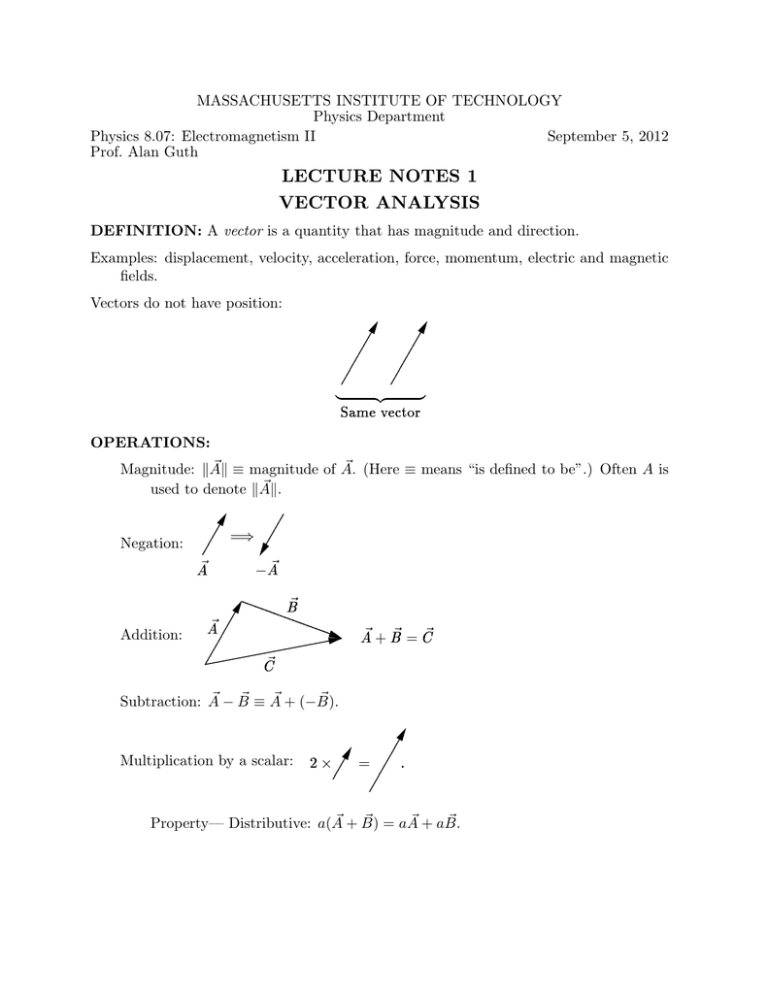Document 13614603
advertisement

MASSACHUSETTS INSTITUTE OF TECHNOLOGY Physics Department Physics 8.07: Electromagnetism II September 5, 2012 Prof. Alan Guth LECTURE NOTES 1 VECTOR ANALYSIS DEFINITION: A vector is a quantity that has magnitude and direction. Examples: displacement, velocity, acceleration, force, momentum, electric and magnetic fields. Vectors do not have position: OPERATIONS: A ≡ magnitude of A A . (Here ≡ means “is defined to be”.) Often A is Magnitude: IAI A used to denote IAI. Negation: Addition: A −B A ≡A A + (−B). A Subtraction: A Multiplication by a scalar: A + B) A = aA A + aB. A Property— Distributive: a(A 8.07 LECTURE NOTES 1, FALL 2012 p. 2 A ·B A ≡ |A A ||B A | cos θ, where θ is the angle between A A and Dot product of two vectors: A A B: Properties: Rotational invariance. The value of the dot product does not change if both of the vectors are rotated together. A·B A =B A · A. A Cummutative: A A · (B A +C A) = A A ·B A +A A ·C A. Distributive: A A) · B A = a(A A·B A ). Scalar multiplication: (aA Query: Why cos θ??? If I defined a Guth-dot product by A·B A A Guth A ||B A | sin θ , ≡ |A and hired a really good advertising agency, could my product (note the pun!) compete? Tentative answer: Maybe a really good advertising agency can do anything, but I would have a serious marketing problem. My dot product would not be A ·B A obeys rotational invariance distributive. In fact, one can show that if A and the distributive law, then A·B A = const|A A ||B A | cos θ . A We’ll come back to this later. 8.07 LECTURE NOTES 1, FALL 2012 p. 3 Cross product of two vectors: A×B A ≡ |A A ||B A | sin θ n̂ , A A and perpendicular to B A . The choice where n̂ is a unit vector perpendicular to A A and B A is of the two (opposite) directions that are perpendicular to both A determined by the right-hand rule: (Source: Modified from chortle.ccsu.edu/vectorlessons/vch12/rightHandRule.gif.) Properties: Rotational invariance: If both vectors are rotated by the same rotation R, then the result of the cross product is also rotated by R. A ×B A = −B A ×A A . Anticommutative: A A × (B A +C A) = A A ×B A +A A×C A . Distributive: A A) × B A = a(A A×B A ). Scalar multiplication: (aA Query: Why sin θ??? Answer: Again, the function of θ is required for rotational invariance and dis­ tributivity. If these two properties hold, then one can show that A×B A = const|A A ||B A | sin θ n̂ . A COMPONENT FORM: A = Ax êx + Ay êy + Az êz , A where êx is a unit vector in the direction of the positive x-axis. (Various notations are in use. Griffiths uses x̂, ŷ, and ẑ, and many other books use ı̂, ̂, and k̂.) Operations: Vector addition: A+B A = (Ax + Bx )êx + (Ay + By )êy + (Az + Bz )êz . A 8.07 LECTURE NOTES 1, FALL 2012 p. 4 Vector dot product: A·B A = (Ax êx + Ay êy + Az êz ) · (Bx êx + By êy + Bz êz ) . A êx · êx = êy · êy = êz · êz = 1 , and êx · êy = 0, as does the dot product of any two basis vectors. A·B A = Ax Bx + Ay By + Az Bz . ... A Return to query: why cos θ??? Rotational invariance =⇒ êx · êx = êy · êy = êz · êz = const. What about êx · êy ?: Rotational invariance also implies that êx · êy = êx · (−êy ) , since the pair (êx , −êy ) can be obtained from the pair (êx , êy ) by ro­ tating both vectors 180◦ about the x-axis: Thus êx ·êy + êx ·(−êy ) = 2êx ·êy . But then the distributive law implies that êx · êy + êx · (−êy ) = êx · (êy + (−êy )) = êx · A0 = 0 . Similarly the dot product of any two distinct basis vectors must vanish, so A·B A = const (Ax Bx + Ay By + Az Bz ) . A A ||B A | cos θ, but we can see it This had better be equivalent to const|A A along the pos­ explicitly by using the rotational invariance to orient A A itive x-axis, so Ax = |A|, and Ay = Az = 0. Then the above formula A·B A = const Ax Bx , but Bx = |B A | cos θ, where θ is the angle gives A A and the x-axis, but that is also the angle between B A and between B A A. 8.07 LECTURE NOTES 1, FALL 2012 p. 5 Vector cross product: A×B A = (Ax êx + Ay êy + Az êz ) × (Bx êx + By êy + Bz êz ) , A where êx × êx = êy × êy = êz × êz = 0 , and êx × êy = êz , and cyclic permutations, êy × êz = −êz , and cyclic permutations. Expanding, A ×B A = (Ax By − Ay Bx )ˆ A ez + (Ay Bz − Az By )ˆ ex + (Az Bx − Ax Bz )ˆ ey . Equivalently, one can write êx A A A × B = det Ax Bx êy Ay By êz Az . Bz MIT OpenCourseWare http://ocw.mit.edu 8.07 Electromagnetism II )DOO For information about citing these materials or our Terms of Use, visit: http://ocw.mit.edu/terms.

